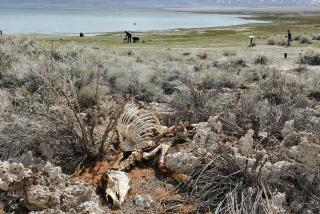Logging With Horses Trots Toward a Small Comeback in the Northwest
- Share via
SEATTLE — The scene resembles a 19th century pastoral painting as Joe Warness begins another workday by harnessing up his team of draft horses, two black geldings named Tom and Jerry, and heading for the woods.
Warness, a 45-year-old contract logger, spends the day thinning stands of Douglas fir on a tree farm near Chehalis in southwestern Washington. He works alone with the team, felling trees, cutting them into 40-foot lengths and using the horses to haul them out of the woods to the nearest logging road.
“I always wanted to work with draft horses,” said the bearded, soft-spoken Warness, a logger off and on for the last 25 years who began using horses four years ago. Horse logging, the norm in the United States 100 years ago, never completely disappeared, but it is enjoying something of a revival because it is easier on the environment than mechanized logging.
“There’s not as much root damage, not as much soil compaction and not as much mud,” Warness said. “And when you’re done, it looks more like a park than a logging site.”
The actual number of horse loggers “ebbs and flows a little bit with the general logging economy,” said Glenn French, 54, president of the Otis, Ore.-based North American Horse and Mule Loggers Assn., which has 108 members, up from 20 when it was founded in 1991.
He said there were three people logging with horses in Washington state, including Warness.
“Horse logging is a little more sensitive to the environment,” French said. “We’ve always appealed to the small woodland owner who’s sensitive to what happens on his wood lot. That’s what we try to sell.”
French, who has logged with horses since 1973, does a lot of what he calls “danger tree removal”--removing trees near houses that might blow down in a storm.
Warness said he had thought private landowners would be his biggest customers, but many balk at the higher cost of logging with horses. Typically, he said, a contract logger will charge a percentage of the wood’s value, perhaps 35% to 40% if the harvest is small trees destined for local sawmills. He charges 45% to 50% for the same job.
“They sit there and think about that extra 10%,” he said, “[but] then they’re sorry about the mess they’re left with” after mechanized loggers are through.
For the last two years, Warness has worked almost exclusively for Seattle-based Port Blakeley Tree Farms, a private company that has used horse loggers for more than 15 years, said Court Stanley, a forester in its Chehalis field office.
“They have their niche,” Stanley said. The company hires Warness to thin stands of 25- to 35-year-old trees on smaller parcels of fairly flat ground.
“They can fit through smaller spaces,” Stanley said of Warness and his team. “We don’t have to take trees out for the equipment to fit through. He can weave through the trees.”
Stanley also praises Warness for not damaging the remaining trees. “We don’t want damage on our trees, on the ones that are going to stay. Joe does a really good job of not damaging any of the trees that are left.”
Warness speaks with some frustration of the limitations of working with horses. “The conditions have to be just right,” he said. “There’s such a narrow window you can work in with the horses.”
That “window,” he said, is trees up to 18 inches in diameter. Smaller than that, he cannot make enough money. Larger than that, his Percherons cannot pull the load.
Even with a sideline of shoeing horses, he said his business, which he started with $30,000 four years ago, has not been profitable so far. “I would like the job really well if the profit was better and I was going home every night,” said Warness, who sleeps in a trailer near the job site and sets up a temporary corral for his horses.
His dream is to farm using the horses. “Horses are starting to make a comeback on small family farms,” he said. “And it’s kinder and gentler on the horses.”
But sometimes he cannot help comparing the extra work horse logging demands with mechanized logging. “You have to get up before work and feed ‘em, and after work you’ve got to unharness and groom ‘em and feed ‘em. And if they throw a shoe on the job, you’re done for the day.”
More to Read
Sign up for Essential California
The most important California stories and recommendations in your inbox every morning.
You may occasionally receive promotional content from the Los Angeles Times.












